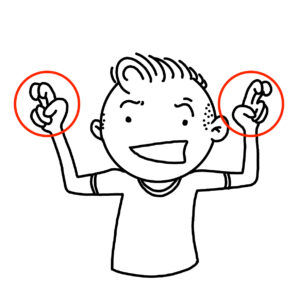Quotation Marks

Quotation marks have several simple uses, and a lot of specific rules. Try learning the general rules first, and focus on the details later. (There are a lot of details.)
1. Direct Quotes
Use quotation marks to show exactly what people said:
Allan said, “I want to go out for dinner tonight.“
“Really!?“ asked Barbara. “We went out last night.“
“I know,“ replied Allan, “but I’m in the mood to go out.“
Watch out for punctuation.
A. Commas
Use a comma after words like said, asked, or replied.
Allan said, “I want to go out for dinner tonight.”
Use a comma when a full quote is split.
“I know,“ replied Allan, “but I’m in the mood to go out.“
Quoted exclamation or question marks replace commas.
“I’m the king of the world!” screamed Jack.
“Where do you think you’re going?” asked Robin.
Do not use a comma if the quotation marks are not used for quotes.
My parents were “talking” in the kitchen last night. = used for irony
Use “on” with days and dates. = used to highlight a grammar point
B. Capitalization
Do not use a capital letter for words like said, asked, or replied.
O “Really!?” asked Barbara.
X “Really!?” Asked Barbara.
Use a capital letter if the quote is a full sentence.
“Really!?” said Barbara. “We went out last night.”
Do not use a capital if the quote is not a full sentence.
O “I know,” replied Allan, “but I’m in the mood to go out.”
X “I know,” replied Allan, “But I’m in the mood to go out.”
Inside or Outside the quotation marks?
In the US, sentence ending punctuation goes inside quotation marks:
O Carl said, “I need a napkin.“
X Carl said, “I need a napkin”.
Be careful!
Punctuation goes outside the quotation marks in questions.
Why does the baby cry every time someone says “hello”?
If it’s part of the quote, punctuation goes inside.
“Why does the baby cry every time someone says ‘hello’?” asked Barbara.
C. Quotes inside quotes
Notice, when a quote is inside a quote, we use single quotation marks:
The teacher stood up and announced, “As Nietzsche famously said, ‘Whatever doesn’t kill you makes you stronger.‘“
D. Long Speech
When a character is speaking for a long time, or when quoting a long piece of text, put quotation marks at the beginning and end. However, if the text goes on to the next page, be sure to put a new open quotation mark at the start of the new page to show the quote is continued from before.
Other Uses
1. Quotation marks show Irony
Allan and Barbara are really good “friends.” = They are more than friends.
My parents were “talking” in the kitchen last night. = They were fighting.
2.Air Quotes
We can’t see quotes when we are speaking. So, sometimes, people gesture with two fingers to show they are making a quote. However, this is usually used to mean something is funny or ironic.
3. When a word doesn’t fit a sentence grammatically. I often use this when giving students feedback.
Use “on” with days and dates.
Use “at” with clock time.
Wow! That is a lot to remember. Try to remember the general rules first, and use this as a reference when you aren’t sure of the details. As my favorite trainer, Tony Horton, once said, “Do your best, and forget the rest!”
Like this post? Did I forget something? Let me know!



